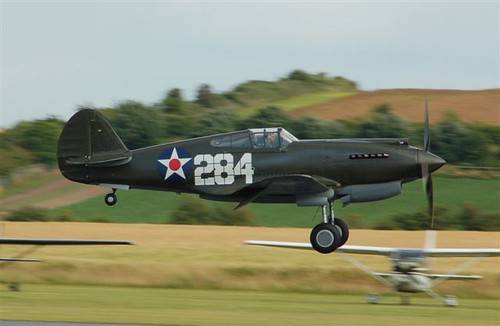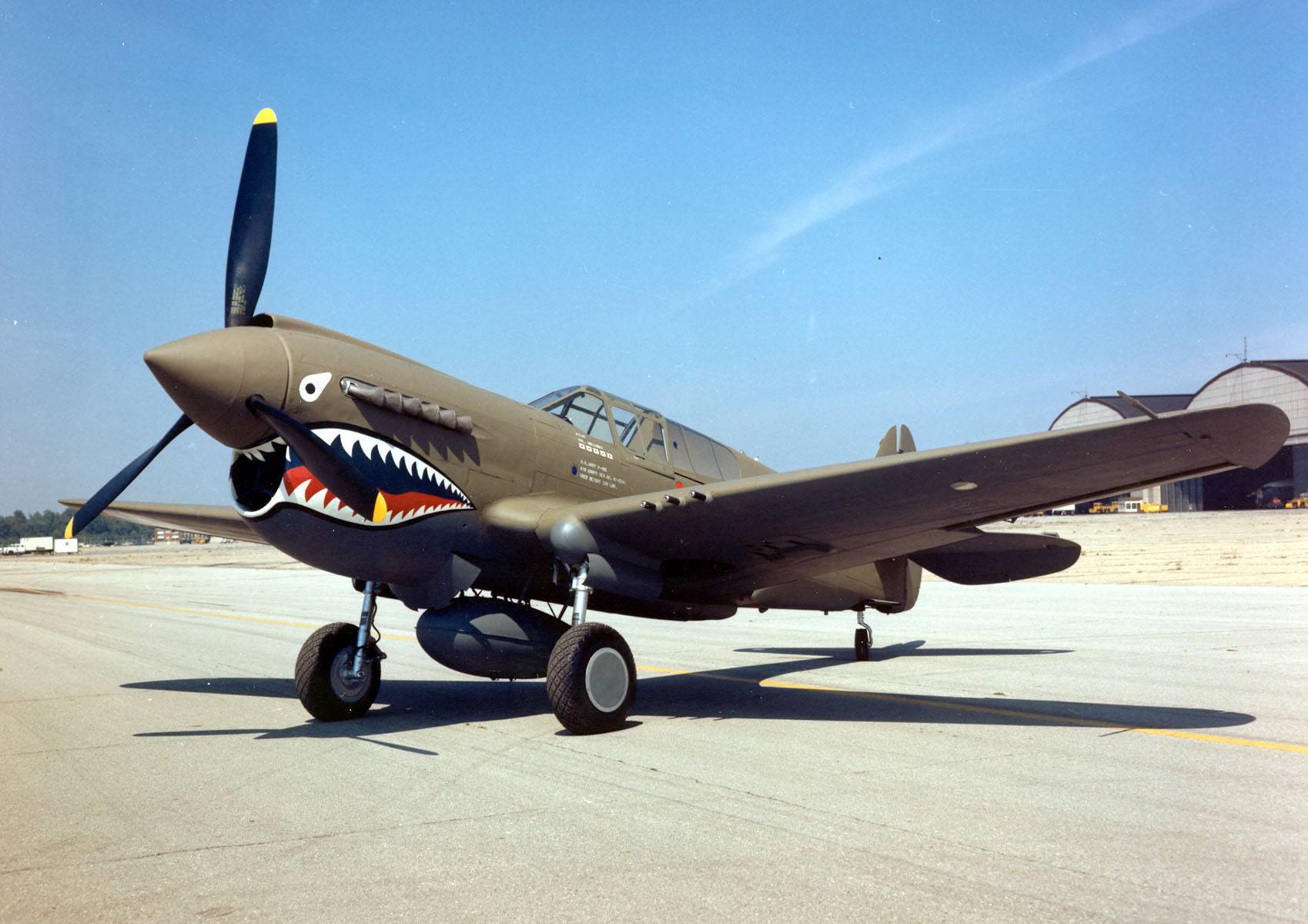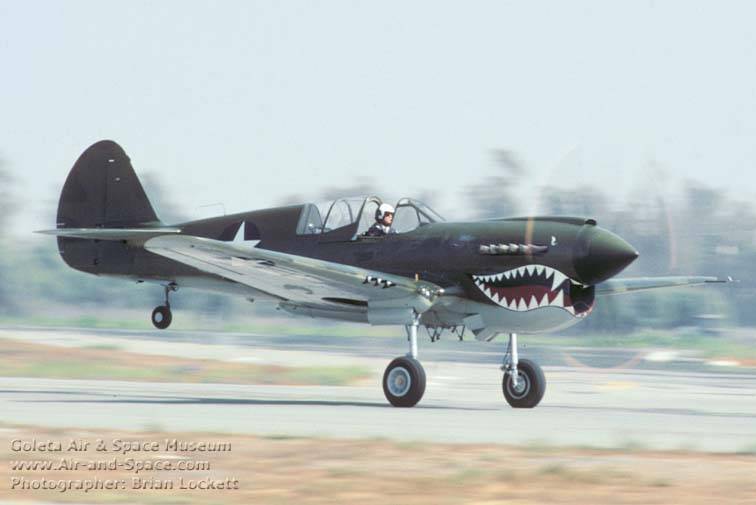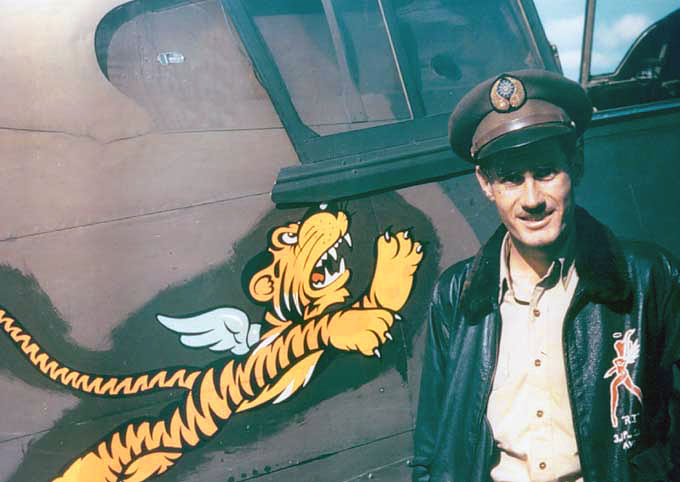Xenophon
Gone and forgotten
Something new, the weapons of the war.
Tomahawk, Kittyhawk, Warhawk
The Curtiss P-40 served with the USAAF and other allied air forces in every operational theatre of World war II; it was built in considerable numbers and proved to be highly adaptable to a variety of tasks. The P-40 Hawk was built to operate at low altitudes, to support ground action, and to attack enemy rear columns and depots.
The plane was a redesign of the P-36 Mohawk, a radial engined fighter that was considered slow for modern combat (yet served in France in 1940, as well as Finland throughout the war, to great success) . An order for 140 P-40 aircraft for the French government was in 1940 diverted to Britain, who named the machine the Tomahawk Mk I. Most of these Tomahawks, as well as the IIA version, later received, were sent to the Middle East or to Army co-operation units. During this period prior to Pearl Harbor, Curtiss supplied 100 P-40Bs from a British order to Chennault's American Volunteer Group in China. In air combat in the Middle East and in the early months of the Pacific War, when the P-40 fared badly against more maneuverable Messerschmidts and Zeros, Chennault in China had great success with the type. He taught his pilots to use the planes strengths, which were high dive speeds, incredible ruggedness, and devastating firepower to the best use, by making high speed dives and not attempting to engage the enemy in dogfights. The USAAF was slow to understand these lessons, and allied pilots paid for it with their lives, and with lost operational aircraft. When used correctly, the P-40 was nearly unbeatable, a Bf 109 or a Zero could not dive with it, nor could either axis fighter take the punishment a P-40 could and keep flying.
The first substantial redesign appeared in the P-40D of 1941, which had an Allison V-1710-39 engine. The four wing guns were changed from .30 caliber to the more effective .50 caliber, and provision was made for bombs and a dropable fuel tank to be carried beneath the fuselage.
In the Pacific the P-40D (called Kittyhawk by the British) bombed enemy bases and could also engage enemy fighters. Named Kittyhawk I by the RAF, the aircraft was used to similar effect against Rommel's Afrika Korps. The type was continually developed, but the last version, the Warhawk, was the most famous. Its armament was increased to 6 wing mounted .50 caliber MGs, the Allison engine was uprated for increased performance, and the speed went up to a respectable 375 MPH. This version, called the P-40E, was the most successful of all the versions, and cost the Germans and the Japanese considerable problems in 1942. The final production version, the P-40N, was actually a step backward, as it was slower and often armed with only 4 guns instead of 6, and was intended for mass production and export, and was used by the United States mainly for ground support, as the P-38, P-47 and the P-51 had all eclipsed the P-40. The P-40s' chief designer claimed that the North American P-51 Mustang was actually based on a redesigned P-40, as North American employed several of the P-40 engineers in its design department. The redesigned P-40 was found to equal the Mustang, but the USA was not willing to give Curtiss a contract for it, so it died stillborn.
The P-40 was often called "the best second best fighter of World War II." However, the record shows that when it was used correctly, it was second to no aircraft of its era.
P-40B
Length: 31ft 8in
Span : 37ft 3in
Armament : 4 x .30 cal 2 x .50 cal
Powerplant : Allison V-12 1,100 HP Liquid cooled engine
Performance
Speed : 352 MPH
Ceiling : 30,000ft
Range : 450 miles
P-40E
Length : 31 ft 2 in
Span : 37 ft 4 in
Armament : 6 x .50 cal
Powerplant : Allison V-1710 1,150 HP Liquid cooled engine
Performance
Speed : 364 MPH
Ceiling : 34,400 ft
Range : 1,500 miles with external fuel tank
P-40N
Length : 33 ft 4 in
Span : 37 ft 4 in
Armament : 4 or 6 x .50 cal, up to 2,000 pounds of bombs
Powerplant : Allison V1710-99 1,200 HP Liquid cooled engine
Performance
Speed : 343 MPH
Ceiling : 30,000 ft
Tomahawk, Kittyhawk, Warhawk
The Curtiss P-40 served with the USAAF and other allied air forces in every operational theatre of World war II; it was built in considerable numbers and proved to be highly adaptable to a variety of tasks. The P-40 Hawk was built to operate at low altitudes, to support ground action, and to attack enemy rear columns and depots.
The plane was a redesign of the P-36 Mohawk, a radial engined fighter that was considered slow for modern combat (yet served in France in 1940, as well as Finland throughout the war, to great success) . An order for 140 P-40 aircraft for the French government was in 1940 diverted to Britain, who named the machine the Tomahawk Mk I. Most of these Tomahawks, as well as the IIA version, later received, were sent to the Middle East or to Army co-operation units. During this period prior to Pearl Harbor, Curtiss supplied 100 P-40Bs from a British order to Chennault's American Volunteer Group in China. In air combat in the Middle East and in the early months of the Pacific War, when the P-40 fared badly against more maneuverable Messerschmidts and Zeros, Chennault in China had great success with the type. He taught his pilots to use the planes strengths, which were high dive speeds, incredible ruggedness, and devastating firepower to the best use, by making high speed dives and not attempting to engage the enemy in dogfights. The USAAF was slow to understand these lessons, and allied pilots paid for it with their lives, and with lost operational aircraft. When used correctly, the P-40 was nearly unbeatable, a Bf 109 or a Zero could not dive with it, nor could either axis fighter take the punishment a P-40 could and keep flying.
The first substantial redesign appeared in the P-40D of 1941, which had an Allison V-1710-39 engine. The four wing guns were changed from .30 caliber to the more effective .50 caliber, and provision was made for bombs and a dropable fuel tank to be carried beneath the fuselage.
In the Pacific the P-40D (called Kittyhawk by the British) bombed enemy bases and could also engage enemy fighters. Named Kittyhawk I by the RAF, the aircraft was used to similar effect against Rommel's Afrika Korps. The type was continually developed, but the last version, the Warhawk, was the most famous. Its armament was increased to 6 wing mounted .50 caliber MGs, the Allison engine was uprated for increased performance, and the speed went up to a respectable 375 MPH. This version, called the P-40E, was the most successful of all the versions, and cost the Germans and the Japanese considerable problems in 1942. The final production version, the P-40N, was actually a step backward, as it was slower and often armed with only 4 guns instead of 6, and was intended for mass production and export, and was used by the United States mainly for ground support, as the P-38, P-47 and the P-51 had all eclipsed the P-40. The P-40s' chief designer claimed that the North American P-51 Mustang was actually based on a redesigned P-40, as North American employed several of the P-40 engineers in its design department. The redesigned P-40 was found to equal the Mustang, but the USA was not willing to give Curtiss a contract for it, so it died stillborn.
The P-40 was often called "the best second best fighter of World War II." However, the record shows that when it was used correctly, it was second to no aircraft of its era.
P-40B
Length: 31ft 8in
Span : 37ft 3in
Armament : 4 x .30 cal 2 x .50 cal
Powerplant : Allison V-12 1,100 HP Liquid cooled engine
Performance
Speed : 352 MPH
Ceiling : 30,000ft
Range : 450 miles
P-40E
Length : 31 ft 2 in
Span : 37 ft 4 in
Armament : 6 x .50 cal
Powerplant : Allison V-1710 1,150 HP Liquid cooled engine
Performance
Speed : 364 MPH
Ceiling : 34,400 ft
Range : 1,500 miles with external fuel tank
P-40N
Length : 33 ft 4 in
Span : 37 ft 4 in
Armament : 4 or 6 x .50 cal, up to 2,000 pounds of bombs
Powerplant : Allison V1710-99 1,200 HP Liquid cooled engine
Performance
Speed : 343 MPH
Ceiling : 30,000 ft






